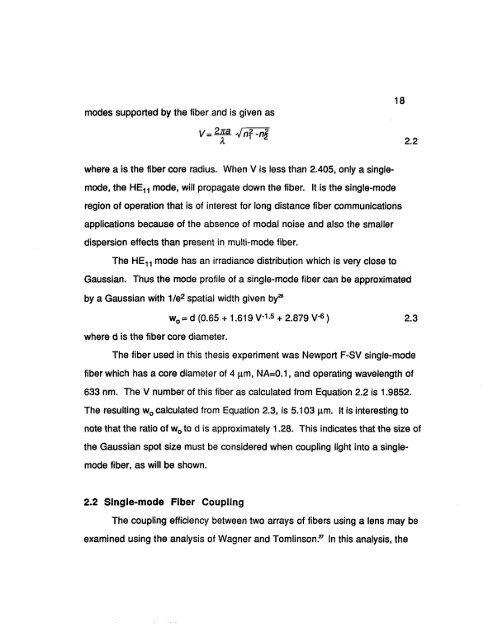azu_td_1349475_sip1_... - Arizona Campus Repository
azu_td_1349475_sip1_... - Arizona Campus Repository
azu_td_1349475_sip1_... - Arizona Campus Repository
You also want an ePaper? Increase the reach of your titles
YUMPU automatically turns print PDFs into web optimized ePapers that Google loves.
modes supported by the fiber and is given as<br />
18<br />
2.2<br />
where a is the fiber core radius. When V is less than 2.405, only a singlemode,<br />
the HE^ mode, will propagate down the fiber. It is the single-mode<br />
region of operation that is of interest for long distance fiber communications<br />
applications because of the absence of modal noise and also the smaller<br />
dispersion effects than present in multi-mode fiber.<br />
The HE n mode has an irradiance distribution which is very close to<br />
Gaussian. Thus the mode profile of a single-mode fiber can be approximated<br />
by a Gaussian with 1/e 2 spatial width given by 26<br />
w 0 = d (0.65 + 1.619 V" 1 - 5 + 2.879 V" 6 ) 2.3<br />
where d is the fiber core diameter.<br />
The fiber used in this thesis experiment was Newport F-SV single-mode<br />
fiber which has a core diameter of 4 ^m, NA=0.1, and operating wavelength of<br />
633 nm. The V number of this fiber as calculated from Equation 2.2 is 1.9852.<br />
The resulting w 0 calculated from Equation 2.3, is 5.103 (xm. It is interesting to<br />
note that the ratio of w 0 to d is approximately 1.28. This indicates that the size of<br />
the Gaussian spot size must be considered when coupling light into a singlemode<br />
fiber, as will be shown.<br />
2.2 Single-mode Fiber Coupling<br />
The coupling efficiency between two arrays of fibers using a lens may be<br />
examined using the analysis of Wagner and Tomlinson. 27 In this analysis, the
















